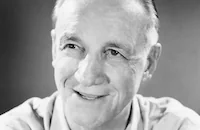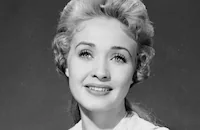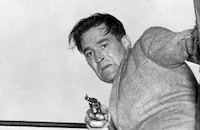Enchanted Island

Brief Synopsis
Cast & Crew
Allan Dwan
Dana Andrews
Jane Powell
Don Dubbins
Arthur Shields
Ted De Corsia
Film Details
Technical Specs

Synopsis
In 1842, after fourteen months at sea, the sailors of the American whaling ship The Dolly ask permission from Captain Vangs for shore leave when the ship docks to take on provisions at the remote South Sea island of Nukuheva. Oppressive and puritanical, the captain refuses their request, warning of island cannibals and condemning the men for their debauchery with island women. When young Tom adamantly argues that they need the rest, his shipmate Abner Bedford reminds Vangs that he is contractually obligated to give shore leave to the men. Vangs at first agrees but then starts a fight in which Abner knocks out Vangs and Tom is knifed in the arm.
Fearing retribution for their insubordination, Abner and Tom rush into the jungle, where they know two tribes reside: the friendly Happar and the cannibalistic Typee. Abner explains that if they can manage to elude the Typee and make it to other side of the island, they might find another ship. That night as they rest, Abner admits that he hungers for freedom and had planned on jumping ship all along. Meanwhile, Vangs, desperate for sailors, hires expatriate and trading post bar owner Jimmy Dooley to track Abner and Tom and bring them back. Finding the pair, Dooley tries to befriend them by relating his history on the island: Arriving on Nukuheva twenty years ago, Dooley married a local woman and now prostitutes the daughters from that marriage and another to passing "tourists" like themselves.
Dooley promises to show Abner and Tom a hideout in trade for their wages, but instead leads them to a group of armed natives, forcing Abner and Tom to fend for their lives. Fleeing in the opposite direction, Abner and Tom spot a village and are discovered by young native Fayaway, who leads them to her grandfather, Typee tribal chief Mehevi. Imprisoned in a thatched hut under armed guard, Abner watches over an ailing Tom all night and wonders how long they will survive. The next day, after Abner asks Fayaway to help Tom, who is now delirious with fever, she sends for the village medicine men, who attend to his wound. Days later, Dooley brings goods to Mehevi to trade for the two sailors, but his offer is refused. Dooley then explains to Abner that the green-eyed Fayaway is the daughter of a shipwrecked white man and a village woman, thus explaining the color of her eyes.
As the days pass, Fayaway and guard Kory Kory care for the men, while Abner teaches Fayaway English. Having fallen for the young woman, Abner tries to introduce the idea of "love" to her, but she teasingly resists his advances. Soon after, when a warring tribe attacks the Typee, Tom suggests that he and Abner take the opportunity to flee, but Abner, having grown accustomed to island life, fights for his new friends and saves Mehevi's life in battle. After the battle is won, the chief invites Tom and Abner to the victory banquet, but Tom fears that they will be forced to eat the flesh of the recently captured prisoners and runs from the table. Abner, realizing that the meat is pork, joins the festivities and secures his place as a loyal villager. Over the next weeks, Fayaway and Abner's romance blossoms under Mehevi's watchful eye. Tom repeatedly implores Abner to escape, but the island life provides Abner with the freedom he sought and so he declines.
Desperate and naïve, Tom denounces Abner's relationship with a tribeswoman, insinuates that he will become a savage if he remains, and escapes that night, leaving a note asking Abner not to search for him and informing his friend that he took his axe. While fishing with the tribesmen weeks later, Abner playfully nets Fayaway and carries his "fish" away, while the villagers laugh approvingly. Abner and Fayaway are soon married and Abner begins to learn the Typee Language. One day, after spotting shoe prints resembling Tom's, Abner asks his wife about his former shipmate, but Fayaway claims she knows nothing. When he later finds a young boy wearing Tom's shirt and sees the medicine man wielding Tom's axe, Abner wrests the instrument from the medicine man during a ritual and demands to know his friend's location. Mehevi replies that they killed Tom for fear that he would send white men to destroy them and then condemns both Abner and Fayaway to die for the taboo of interrupting the ritual.
The next morning as the couple awaits their execution, Vangs' ship is spotted just off shore. As Kory Kory distracts the villagers, Fayaway cuts a hole in the thatch hut, admits to Abner that she deceived him and tells him to return to his people, but Abner refuses to go to the ship without her. As they paddle toward the ship with Mehevi and his men in close pursuit, Vangs sends a small boat to fetch them. When Abner boards it, however, the sailors knock him out to prevent him from going after Fayaway, who has turned back toward her people. Abner regains consciousness onboard the ship and jumps overboard to fetch Fayaway, forcing Vangs to send another boat out after him. Caught between Abner and Mehevi, Fayaway begs her chief to spare Abner. The chief, touched by their devotion, puts down his spear, but the medicine man sadistically spears Fayaway, wounding her in the back. Mehevi can only watch in despair as Abner carries the girl's limp body back to the ship, where Vangs jokingly yells that a married man makes a bad first mate.

Director

Allan Dwan
Cast

Dana Andrews

Jane Powell

Don Dubbins

Arthur Shields

Ted De Corsia
Friedrich Ledebur
Augustín Fernández
Francisco Reiguera
Les Hellman
Eddie Saenz
Dale Van Sickel
Paul Stader
Crew
Robert Allen
Benedict Bogeaus
Benedict Bogeaus
Weldon Coe
Hal Wilson Cox
Burris Grimwood
Raúl Lavista
James Leicester
James Leicester
Nacio Real
Albert M. Simpson
Albert M. Simpson
Harold Jacob Smith
George Stahl
Albert E. Valenzuela
Lee Zavitz
Lee Zavitz

Videos
Movie Clip



Trailer
Film Details
Technical Specs

Articles
Enchanted Island
By Richard Harland Smith

Enchanted Island
Quotes
Trivia
Notes
Enchanted Island was based on Herman Melville's novel Typee, which was also the film's working title, but differs from the novel in several ways: In Enchanted Island the Typees' cannibalism is never confirmed, while in the novel the lead character witnesses the ritualized eating of human flesh. Additionally, in the novel, "Fayaway" does not escape with "Abner," but escapes with a man who is looking for an additional crew member for a whaling ship. Typee was also used as the basis for M-G-M's 1935 film Last of the Pagans, which is only loosely based on the novel (See AFI Catalog of Feature Films, 1931-40). Enchanted Island was shot on location on the west coast of Mexico.















